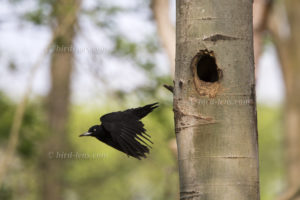 Spring is marked by striking drums that reverberate loudly through the forest. In addition to their drumming, the calls, which can be heard especially in spring and autumn and allow the species to be distinguished from afar, are noticeable. Like no other bird family, the woodpeckers in Central Europe represent the forest habitat.
Spring is marked by striking drums that reverberate loudly through the forest. In addition to their drumming, the calls, which can be heard especially in spring and autumn and allow the species to be distinguished from afar, are noticeable. Like no other bird family, the woodpeckers in Central Europe represent the forest habitat.
It is the same when, in early spring, powerful hammer blows sound far through the morning forest. All that is missing are the occasional, far-reaching calls to confirm the assumption. The Black Woodpecker (Dryocopus martius) marks its territory.
In his “Handbuch der Vögel Mitteleuropas”, Urs N. Glutz von Blotzheim describes in detail the preferences of Black Woodpeckers with regard to their breeding trees. The black woodpecker is quite picky about cave trees. For the creation of breeding and sleeping caves, the Black Woodpecker primarily prefers old beeches. This predilection usually makes the Black Woodpecker a typical inhabitant of deciduous forests in Central Europe.
Almost all woodpeckers build caves and thus open up resting, breeding and food sources for a variety of animal species. They are therefore of particular importance for the forest ecosystem. Numerous fascinating adaptations to the tree as shelter and food source characterize this group of birds, as well as their high cognitive abilities. The self-made caves, specially set up forges as a simple form of tool use, ring marks on trees, and the almost omnipresent chopping marks bear witness to the presence of woodpeckers in our forests. Bird-lens.com has written about woodpeckers in their breeding burrows for some species. So for the Black Woodpecker breeding in poplar tree, Middle Spotted Woodpecker (Dendrocopos medius) or the Lesser Spotted Woodpecker in orchards.
Each species has its own preferences. Smaller woodpeckers often use dead trees that are already quite rotten to build their caves. The Lesser Spotted Woodpecker (Dendrocopos minor), for example, needs soft, easy-to-work wood for its breeding cave. These lightweight caves are not permanent and are usually only suitable for one breeding season. But there are also two small titmice species in our forests that create tree hollows: the Willow Tit (Poecile montanus) and the Crested Tit (Lophophanes cristatus). Because of their small body size and their dainty beaks, they can only work on soft, heavily dried wood from willow, poplar or birch. In this respect, the demands of the Willow Tit and the Crested Tit do not differ significantly from those of the Lesser Spotted Woodpecker, which is also only sparrow-sized. Birch stumps are right at the top of the popularity list, because the elastic and fairly weather-resistant bark of the birch gives even heavily rotten trunks considerable stability.
In order to meet the growing demand for top images of the rarer species of Palaearctic Bird-lens.com has specifically made trips to remote places. Additionally every chance is used, if a rare bird is around the homeground. This to do everything to ensure excellent photos of the Birds of the Western Palearctic . The yield of pictures also of rare Western Palaearctic birds is very good. There are other nice images of birds, that you will find behind the tab “Picture Shop“. Just give a notice to Bird-lens.com if you need a picture of a bird which is not online.